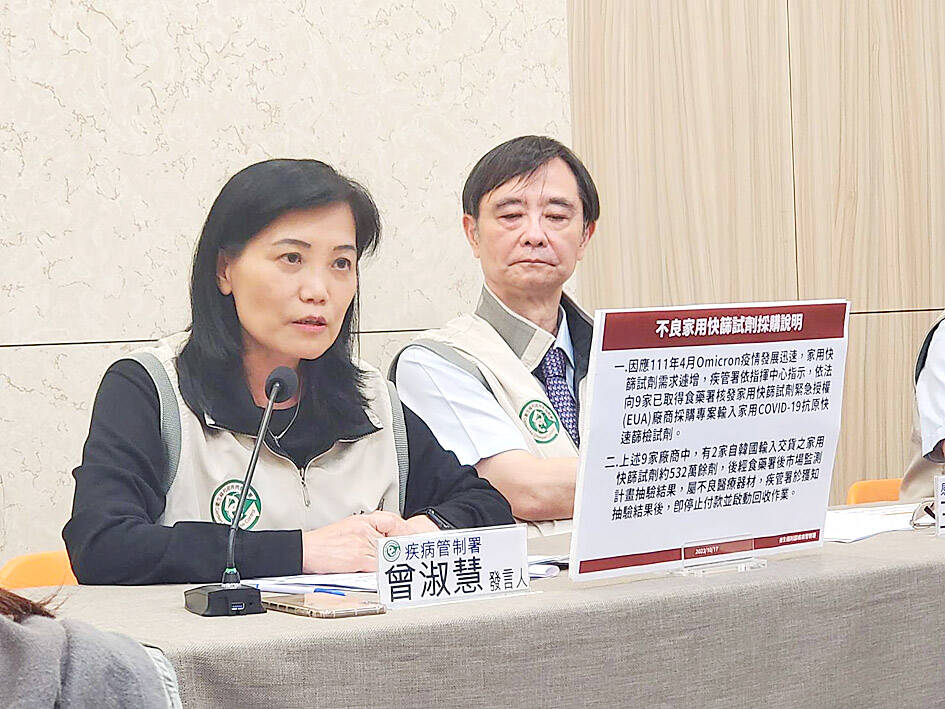Hospitalizations for COVID-19 rose slightly last week, while the first Omicron BA.2.86 case was reported, the Centers for Disease Control (CDC) said yesterday.
There were an average of 43 hospitalized COVID-19 cases per day last week, slightly higher than 39 per day the previous week, while the average number of COVID-19-related deaths per day increased to six from three, CDC Epidemic Intelligence Center Director Guo Hung-wei (郭宏偉) said.
The CDC’s model shows that local COVID-19 cases are expected to gradually rise to a peak in late December, with an estimated 22,000 to 24,000 new cases per day, CDC Deputy Director-General Tseng Shu-hui (曾淑慧) said.

Photo: Lin Hui-chin, Taipei Times
SARS-CoV-2 genomic surveillance data showed that among 41 sequenced local cases, all had Omicron XBB subvariants, including 30 with the EG.5 strain, Guo said.
Among 15 sequenced imported cases, 14 had Omicron XBB subvariants and one had the new Omicron BA.2.86 subvariant, he said.
Tseng said that the imported Omicron BA.2.86 case is a visitor who arrived from Turkey on Sept. 28, marking the first BA.2.86 case detected in Taiwan.
The BA.2.86 subvariant evolved from an Omicron BA.2 sublineage. It has 32 spike protein amino acid mutations compared with BA.2, 35 mutations compared with XBB.1.5 and 58 compared with the earliest strain of COVID-19 in Wuhan, China, she said.
The BA.2.86 subvariant was first detected in Denmark on July 24, Tseng said, adding that as of Monday morning, 654 sequences of the subvariant’s genome had been uploaded to the Global Initiative on Sharing All Influenza Data database.
The WHO on Aug. 17 designated it as a variant under monitoring.
Its mutations are mainly to the spike proteins, so rapid test kits can detect BA.2.86, as they focus on the nucleocapsid protein, Tseng said.
There is no evidence yet that the new subvariant is causing more severe illness, she said, adding that the US Centers for Disease Control and Prevention suggests that updated vaccines should work well against currently circulating COVID-19 variants, including BA.2.86.
As about 78 percent of hospitalized cases are 65 or older and Omicron XBB subvariants are still the dominant variant globally, the CDC urges elderly people to get vaccinated with an XBB.1.5-adapted vaccine to reduce the risk of severe complications and death, Tseng said.
Separately, Chinese Nationalist Party (KMT) Legislator Wang Hung-wei (王鴻薇) said the now-shuttered Central Epidemic Command Center (CECC) spent more than NT$470 million (US$14.55 million) on ineffective COVID-19 rapid test kits from South Korean companies.
The CECC had sought a refund for the defective products, but was afraid the incident would be made public, so it agreed to exchange the defective products, Wang said.
Tseng said that due to sudden demand for at-home rapid test kits in April last year, the Food and Drug Administration (FDA) issued emergency use authorization to nine companies to supply test kits.
Two of the nine companies imported about 5.32 million test kits from South Korea, with Evermedical Co Ltd procuring about 300,000 kits and TST Biomedical Electronics Co procuring about 5.02 million, she said.
An FDA inspection showed that the kits imported by the two companies were ineffective, so the CDC stopped payment for the products and initiated a recall in August, she said.
The kits imported by Evermedical were used, but the CDC had not paid the NT$2.85 million bill for them, she said.
The company sought an intervention by the Public Construction Commission, which said that the cost of the used defective test kits should be NT$0, Tseng said, adding that the CDC would use that figure.
Of the kits imported by TST Biomedical Electronics, 1.33 million were used, with local health departments ordered to recall the remaining 3.69 million kits, she said.
TST Biomedical Electronics was ordered to return the unused kits to South Korea, she said.
The firm imported another batch to replace the 3.69 million test kits and they passed border inspections, she said.
The CECC has paid TST Biomedical Electronics NT$426.575 million, with NT$48.424 million unpaid, but with the 1.33 million defective kits — for which it paid about NT$126.15 million — deemed to be worth nothing, the CDC is seeking a NT$77.72 million refund, she said.

Chinese Nationalist Party (KMT) Chairman Eric Chu (朱立倫), spokeswoman Yang Chih-yu (楊智伃) and Legislator Hsieh Lung-chieh (謝龍介) would be summoned by police for questioning for leading an illegal assembly on Thursday evening last week, Minister of the Interior Liu Shyh-fang (劉世芳) said today. The three KMT officials led an assembly outside the Taipei City Prosecutors’ Office, a restricted area where public assembly is not allowed, protesting the questioning of several KMT staff and searches of KMT headquarters and offices in a recall petition forgery case. Chu, Yang and Hsieh are all suspected of contravening the Assembly and Parade Act (集會遊行法) by holding

PRAISE: Japanese visitor Takashi Kubota said the Taiwanese temple architecture images showcased in the AI Art Gallery were the most impressive displays he saw Taiwan does not have an official pavilion at the World Expo in Osaka, Japan, because of its diplomatic predicament, but the government-backed Tech World pavilion is drawing interest with its unique recreations of works by Taiwanese artists. The pavilion features an artificial intelligence (AI)-based art gallery showcasing works of famous Taiwanese artists from the Japanese colonial period using innovative technologies. Among its main simulated displays are Eastern gouache paintings by Chen Chin (陳進), Lin Yu-shan (林玉山) and Kuo Hsueh-hu (郭雪湖), who were the three young Taiwanese painters selected for the East Asian Painting exhibition in 1927. Gouache is a water-based

Taiwan would welcome the return of Honduras as a diplomatic ally if its next president decides to make such a move, Minister of Foreign Affairs Lin Chia-lung (林佳龍) said yesterday. “Of course, we would welcome Honduras if they want to restore diplomatic ties with Taiwan after their elections,” Lin said at a meeting of the legislature’s Foreign Affairs and National Defense Committee, when asked to comment on statements made by two of the three Honduran presidential candidates during the presidential campaign in the Central American country. Taiwan is paying close attention to the region as a whole in the wake of a

OFF-TARGET: More than 30,000 participants were expected to take part in the Games next month, but only 6,550 foreign and 19,400 Taiwanese athletes have registered Taipei city councilors yesterday blasted the organizers of next month’s World Masters Games over sudden timetable and venue changes, which they said have caused thousands of participants to back out of the international sporting event, among other organizational issues. They also cited visa delays and political interference by China as reasons many foreign athletes are requesting refunds for the event, to be held from May 17 to 30. Jointly organized by the Taipei and New Taipei City governments, the games have been rocked by numerous controversies since preparations began in 2020. Taipei City Councilor Lin Yen-feng (林延鳳) said yesterday that new measures by